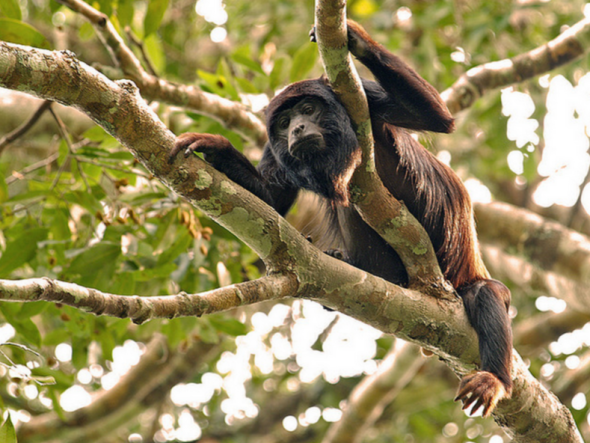Endangered Species Monday: Alouatta belzebul.
Endangered Species Monday: Alouatta belzebul
This Monday’s endangered species article from the (Endangered Species Watch Post) focuses on the Red Handed Howler Monkey of which is listing near to endangerment. (Image Red Handed Howler Monkey)
Generically identified as Alouatta belzebul back in 1766 by Professor Carl von Linnaeus (1707 – 10 January 1778), also known after his ennoblement as Carl von Linné was a Swedish botanist, physician, and zoologist, who laid the foundations for the modern biological naming scheme of binomial nomenclature.
Listed as vulnerable the species is endemic to Brazil (Alagoas, Maranhão, Pará, Paraíba, Pernambuco, Rio Grande do Norte, Sergipe and Tocantins). Populations are currently on the decline of which its very likely the species will be re-categorized as endangered within the next five years, if not sooner.
A. belzebul is said to be extremely common in some areas such as Marajó however is noted as rare within the Atlantic Forest portion of the range known as; Rio Grande do Norte, Alagoas, Paraíba and Pernambuco. Last survey census’s reported the species to be inhabiting at least ten isolated locations of which two hundred individuals remain in each plot.
International Animal Rescue Foundation Brazil have for the past three years been conducting surveys within the area will be submitted to the (IUCN). Furthermore the Environmental Protection Unit now re-based in Londrina are working with local communities, hunters and farmers within the A. belzebul range to preserve commonly known species of monkey, birds, amphibians and flora within the region.
IARFB are also currently conducting investigations to locate where sugar cane is being exported too and used within from the A. belzebul’s region. Its believed that America, Mexico, South America, and Europe are purchasing large sugarcane exports from the region. Tesco, J.S Sainsbury’s, Cooperative Food Group, Asda, Walmart, Woolworths and Spar have all been noted on suppliers exports from the regions. Aldi, Lidl, Quick-Save, Budgens have been ruled out. We are least impressed though with J.S Sainsbury’s name written on export documents of sugar cane from the region.
Within the ten isolated locations six populations are known to reside in Paraiba, two in Rio Grande de Norte, one in Pernambuco, and one in Alagoas. The largest population in the Atlantic Forest is in Pacatuba in Paraiba with about 80 animals. There have been five registered local extirpations from forest fragments in the last 50 years.
Little known conservation actions are under way within their endemic region and as explained populations are decreasing and nearing endangerment. A. belzebul is listed within the family of Atelidae which is one of the very first five of new recognized ‘new world monkeys’. Its quite likely that new sub-species of the Red Handed Howler Monkey may be located as well as newer species of ‘new world monkeys’ too within the coming years. Only five years ago did scientists locate over 100,000 new species within the Yasuni National Park, Ecuador so in reality anything is possible.
The Atelidae family host howler, spider, woolly and woolly spider monkeys (the latter being the largest of the New World monkeys). They are found throughout the forested regions of Central and South America, from Mexico to northern Argentina.
When the species is not foraging on the ground floor they can normally be found resting in the canopies of trees at a height of some sixty feet. Social groups normally consist of seven to twenty members that will host mature males, females juveniles and infants. Males normally take lead of the pack or (troop).
These large and slow-moving monkeys are the only folivores of the New World monkeys. Howlers eat mainly top canopy leaves, together with fruit, buds, flowers, and nuts. They need to be careful not to eat too many leaves of certain species in one sitting, as some contain toxins that can poison them. Howler monkeys are also known to occasionally raid birds’ nests and chicken coops and consume the eggs.
Image: Adult Red Handed Howler Monkey.
Howlers are the only New World primates which regularly include mature leaves in their diet, although softer, less fibrous, young leaves are preferred when they are available. Their folivory and ability to eat mature leaves is undoubtedly one of the keys to their wide distribution and the wide variety of vegetation types they inhabit.
Mature fruit is the other important food item, especially wild figs (Ficus) in many regions, but they also eat leaf petioles, buds, flowers (sometimes seasonally very important), seeds, moss, stems and twigs, and termitaria. The diet of two A. belzebul groups in the Caxiuanã National Forest was studied by Souza et al. (2002). They were largely folivorous but would switch to fruits whenever available, especially during the wet season.
Size:
Adult male weight 7.27 kg (n=27),
Adult female weight 5.52 kg (n=26)
Adult male weight 6.5-8.0 kg (mean 7.3 kg, n=27),
Adult female weight 4.85-6.2 kg (mean 5.5 kg, n=26) .
Threats
Listed on Cites Appendix II there are few threats associated with the species. Nevertheless they still remain and if left unchecked can rapidly increase placing the new world monkey in danger of extinction.
In the Amazon, the species is widespread, although they are hunted. The Amazon populations have suffered severely from forest loss throughout their range in southern Pará over the last decade. In the Atlantic Forest population, the major threat is the fragility of the remaining small forest patches to stochastic and demographic affects (habitat loss and fragmentation has been mainly due to sugar-cane plantations).
Please share and make aware the Red Handed Howler Monkey’s plight. Tip: Check sugar products from local shops and hypermarkets to ensure your not aiding the destruction of their natural habitat via your sugar purchase. Check your local candy and other shopping supplies. If necessary contact companies politely asking where they are obtaining the sugar products from. Never give up.
Thank you for reading.
Dr Jose C. Depre.
Environmental and Botanical Scientist.
Chief Executive Officer




